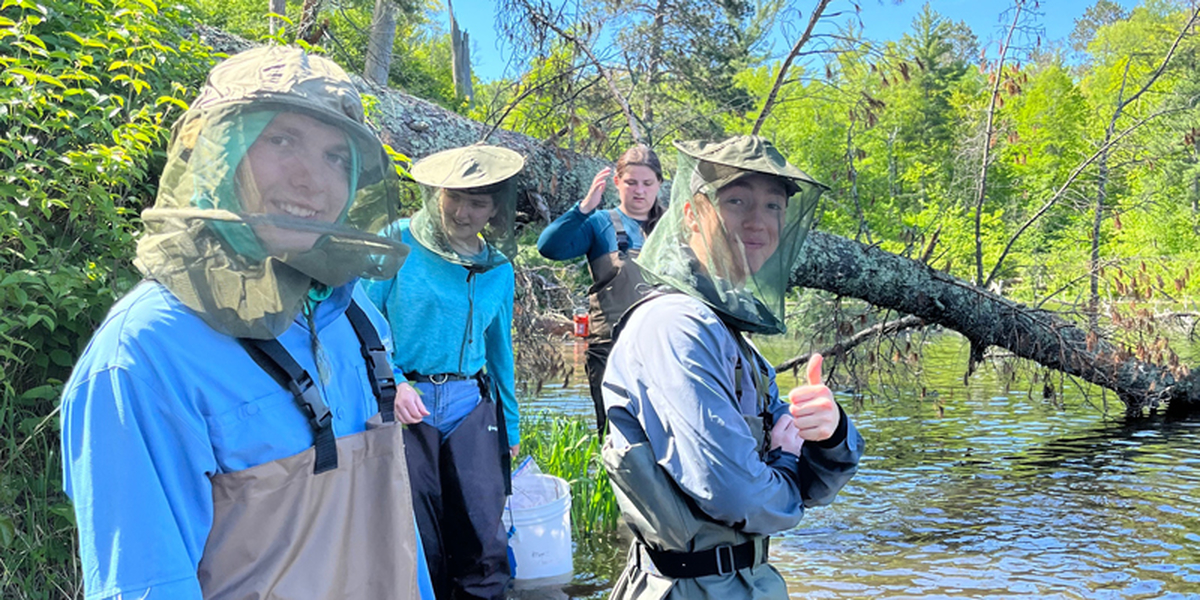
For University of Minnesota undergraduates walking to class amidst a sea of more than 60,000 students, a light rail train passing by and the skyline of one of the largest metros in the country standing as a backdrop, the prospect of field biology is likely not top of mind for many. But that experience of getting out of the classroom, away from the city and slowly sinking into the mud of a lake, foraging through towering pine forests or discovering multicolored fungi on a rotting log is life changing.
“My favorite thing about Itasca was how quiet it was,” shared Lou Hoff, a junior who took field mycology in May 2022. “I love going to school in a major metropolitan area, but sometimes you forget how bad the noise pollution is. I love being able to sit outside, drink coffee, and just listen to the waves lap against the shore and the loons call out.”
Hoff was one of 46 students from the University of Minnesota and other institutions who ventured to Itasca Biological Station and Laboratories this last summer as part of a field biology course. The students took classes on topics ranging from animal behavior to field mycology. And for many, their time at the station created a lasting impact.
“Taking classes at Itasca was the best decision I ever made in my undergraduate career,” says Madie Cloutier who took field mycology and field microbiology in summer 2021. “At Itasca I made great connections with friends, faculty, and nature.”
That love of nature and place sparked an idea: The Itasca Booster Club. Cloutier and classmates came together this last year to build an organization to encourage students to consider heading to Itasca for field biology.
“I created the Booster Club because I wanted to share my love for the research station and the work they do there,” says Cloutier, who now serves as president of the Booster Club. “It is my greatest hope that this club can benefit both the station itself as well as any and all people who are interested in learning and research based in our natural environment.”
For many students who engage in field biology at Itasca, the opportunity is truly unique. Not only do they get to explore the world around them in new and exciting ways, but they also get the chance to build relationships with peers not possible in a normal classroom setting.
“[Itasca] helped me meet my best friends, and provided me with connections not only at the U, but at other schools and with a wide variety of people,” says Izzy Edwards, who took animal behavior and mammalogy in 2021. “You’re with the same group of people for a couple of weeks spending every waking hour with them, you become friends really fast!”
With an expanding reach of students coming to Itasca from not only the University of Minnesota, but Augsburg and other regional institutions in 2022, the Booster Club hopes to continue encouraging enrollments from students both inside and outside of the U of M. Through advocacy and engagement the group hopes to raise awareness about the stations and opportunities available to students over the coming years.
“I want to help other people discover Itasca and learn to love it like I did,” says Jessica Jahn, a fifth-year CBS student who took animal behavior and mammalogy in 2022 and now serves as vice president for the Booster Club. “I learned so much more than I thought I would. I ended up changing my major to Ecology, Evolution and Behavior and I also really discovered my love of fieldwork at Itasca.”
Ultimately, the Booster Club looks toward the future with a hope of encouraging students to engage in these experiences and opportunities for the betterment of the station and the students themselves.
“Going to Itasca solidified my desire to work outdoors,” says Hoff. “I realized I am someone who needs to be able to connect with nature in some way to be happy, so I am now able to focus the rest of my college career on preparing for some sort of job outside.”
– Lance Janssen